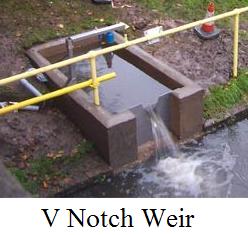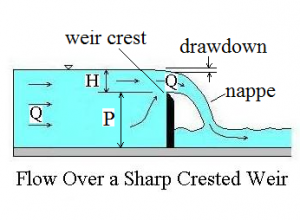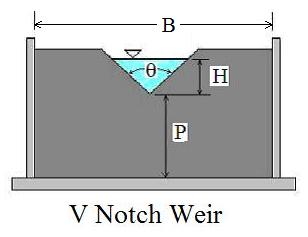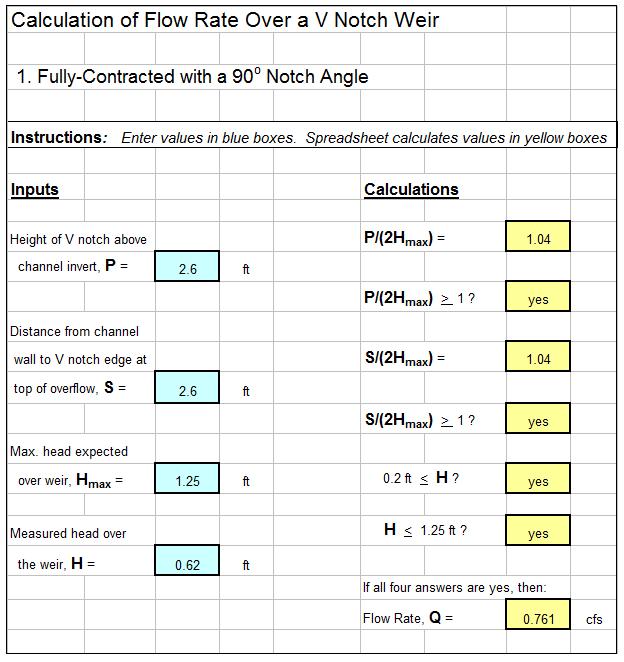Where to Find a V Notch Weir Calculator Excel Spreadsheet
To obtain a V notch weir calculator Excel spreadsheet, click here to visit our spreadsheet store. Why use online calculators or hand calculations when you can buy a V-notch weir calculator excel spreadsheet for only $11.95. Read on for information about Excel spreadsheets that can be used as v-notch weir open channel flow calculators.
As you can see in the diagrams and picture below, the name, v notch weir, is a good description of the device, simply a v shaped notch in a plate placed in an open channel so that the water is forced to flow through the v notch. It can be used to measure the open channel flow rate, because the height of water above the point of the v notch can be correlated with flow rate over the weir. The v-notch weir works well for measuring low flow rates, because the flow area decreases rapidly as the head over the v notch gets small.
Background for Sharp Crested Weirs
 The v notch weir is only one of several possible types of sharp crested weirs. The image at the left shows a picture of a v-notch weir. Acknowledgement of Image Source: RS Hydro www.rshydro.co.uk The diagram below right shows a longitudinal cross-section of a sharp crested weir with several commonly used parameters identified on the diagram. The weir crest is the term used for the top of the weir. In the case of a v notch weir, the crest is the point of the v-shaped notch. The term nappe refers to the sheet of water flowing over the weir. The equations to be
The v notch weir is only one of several possible types of sharp crested weirs. The image at the left shows a picture of a v-notch weir. Acknowledgement of Image Source: RS Hydro www.rshydro.co.uk The diagram below right shows a longitudinal cross-section of a sharp crested weir with several commonly used parameters identified on the diagram. The weir crest is the term used for the top of the weir. In the case of a v notch weir, the crest is the point of the v-shaped notch. The term nappe refers to the sheet of water flowing over the weir. The equations to be discussed in this article for calculating flow over a v-notch weir require free flow over the weir. This means that there must be air under the nappe, as shown in the diagram. The drawdown is the decrease in water level going over the weir caused by the acceleration of the water. The measurement, H, shown in the diagram is referred to as the head over the weir. P in the diagram is the height of the weir crest, and the open channel flow rate (also the flow rate over the weir) is shown as Q.
discussed in this article for calculating flow over a v-notch weir require free flow over the weir. This means that there must be air under the nappe, as shown in the diagram. The drawdown is the decrease in water level going over the weir caused by the acceleration of the water. The measurement, H, shown in the diagram is referred to as the head over the weir. P in the diagram is the height of the weir crest, and the open channel flow rate (also the flow rate over the weir) is shown as Q.
Picture Credit: U.S. Forest Service
A V Notch Weir Calculator Excel Spreadsheet for a 90 Degree Notch Angle
The equation shown below is recommended by the U.S. Dept. of the Interior, Bureau of Reclamation in their Water Measurement Manual (ref #1 below) for calculations with a fully contracted, 90o, v notch, sharp crested weir with free flow conditions and 0.2 ft < H < 1.25 ft.
In U. S. units: Q = 2.49H2.48, where Q is discharge in cfs and H is head over the weir in ft.
In S.I. units: Q = 1.36H2.48, where Q is discharge in m3/s and H is head over the weir in m.
The conditions for the v notch weir to be fully contracted are:
H/P < 0.4, H/B < 0.2, P > 1.5 ft (0.45 m), B > 3 ft (0.9 m)
The diagram above shows the parameters H, P, θ and B for a v notch weir as used for open channel flow rate measurement in a v notch weir calculator excel spreadsheet.
Screenshot of a V Notch Weir Calculator Excel Spreadsheet
The screenshot below shows a v notch weir calculator excel spreadsheet for making 90o, v-notch weir calculations in U.S. units. Based on specified values for H, P, & S, along with Hmax, the maximum expected head over the weir, the spreadsheet checks on whether the required conditions for fully contracted flow are met and then calculates the flow rate, Q. This Excel spreadsheet and others for v notch weir calculations are available in either U.S. or S.I. units at a very low cost (only $11.95) in our spreadsheet store.
References:
1. U.S. Dept. of the Interior, Bureau of Reclamation, 2001 revised, 1997 third edition, Water Measurement Manual, available for online use or download at: http://www.usbr.gov/pmts/hydraulics_lab/pubs/wmm/index.htm.
2. Bengtson, Harlan H., Open Channel Flow III – Sharp Crested Weirs, an online continuing education course for PDH credit, http://www.online-pdh.com/engcourses/course/view.php?id=87
3. Munson, B. R., Young, D. F., & Okiishi, T. H., Fundamentals of Fluid Mechanics, 4th Ed., New York: John Wiley and Sons, Inc, 2002.


